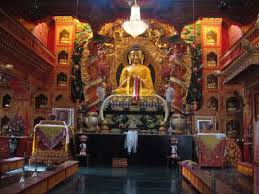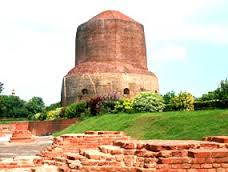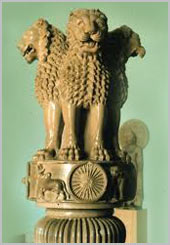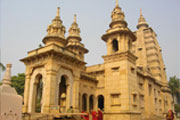|
|
|---|
| Infront of Royal Thai Temple, Bodhgaya -824231 Gaya (Bihar) INDIA |
Sarnath
Located just 12 km from the Hindu holy city of Varanasi, is the deer park of Sarnath, where after his enlightenment, the Buddha first preached the Dharma and the Buddhist Sangha first came into existence.

Situated only 12 km from the city of Varanasi, is the deer park of Sarnath, where after his enlightenment, the Buddha first preached the Dharma and the Buddhist Sangha first came into existence. Having spent seven weeks after his enlightenment in Bodhgaya, the Buddha went in search of his five former companions who had earlier deserted him. From his intuition he came to know that they were leading an ascetic life at Isipattana Migadaya' "the deer park of Sarnath". He found them at the deer park, and here he delivered his first discourse, the Dhammacakkhapavathana Sutta. He explained to his old companions to avoid the two extremes of self-indulgence and self-mortification both of which leads to failure.
The Buddha asked them to avoid both extremes and lead the path of The Middle Way. This can be done by following the Dhamma which is based on the Four Noble Truths i.e., (a) there is suffering; (b) the cause of suffering; (c) the cessation of suffering and (d) the path leading to the cessation of suffering which can be achieved by following the Noble Eightfold Path consisting of Right Speech, Right Action, Right Livelihood, Right Effort, Right Mindfulness, Right Concentration, Right Understanding and Right Thought. His companions understood the preaching and immediately became his followers. Thus was set in motion the "Wheel of Dhamma" or "The First Turning of the Wheel of Dharma." The Buddha spent the subsequent rainy season at Sarnath by which time the Sangha had expanded and had 60 members in its fold. The Buddha sent the members of the Sangha in various directions to preach the Dharma to others.

ATTRACTIONS IN SARNATH
Dhamekha Stupa
Sarnath was attacked by Turkish Muslims towards the end of the 12th century. The site was plundered for building materials and has since remained in ruins. It was entirely deserted until 1836, when excavations and restoration work of the site was started by the British.
Dhamekha Stupa
Sarnath was attacked by Turkish Muslims towards the end of the 12th century. The site was plundered for building materials and has since remained in ruins. It was entirely deserted until 1836, when excavations and restoration work of the site was started by the British.
Dhamekha stupa is the place where the Buddha sat and delivered his first sermon to his first five disciples, who had earlier accompanied him while he was leading an ascetic life. Standing as high of 31.3 m with a diameter of 28.3 m it is the most remarkable structure at Sarnath. Dhamekha stupa was built by Ashoka the great in 249 B.C., and is made partly out of red bricks and stones. Numerous excavation works have been carried out in and around this structure by Cunningham in early 20th century
The Stupa's lower portion is covered entirely with beautifully carved stones. The borders of Dhamekha Stupa are adorned with figures of humans and birds and delicately carved floral designs. The Stupa's base is made of stone and the upper area of brickwork which in all probability may have once had a carved stone fencing.
The Stupa's lower portion is covered entirely with beautifully carved stones. The borders of Dhamekha Stupa are adorned with figures of humans and birds and delicately carved floral designs. The Stupa's base is made of stone and the upper area of brickwork which in all probability may have once had a carved stone fencing.

Chaukhandi Stupa
Standing on a terraced rectangular plinth, the Stupa is capped by an octagonal tower. The Chaukhandi Stupa marks the place where Lord Buddha reunited with his five followers, who had earlier deserted him in Bodhgaya. Chaukhandi Stupa was originally built as a terraced stupa in the 5th century. An octagonal tower was built on the top of the stupa by Akbar in the year 1588 to commemorate the visit of Humayun, his father, at this shrine. The structure is predominantly made out of bricks and thus, is fragile. Chaukhandi has remained out of the favor of Archeological Survey of India for a long time and has been overshadowed by other renowned monuments in Sarnath.
Emperor Ashoka had erected many pillars during his rule of which the most famous pillar is the one with the lion capital found at Sarnath built in 250 B.C., also called as "Asoka Column". The Column still remains in the same place till date whereas the Lion Capital is kept at the Sarnath Museum. The Lion capital found at Saranath consists of four parts from bottom upwards, viz. (a) bell-shaped base covered with inverted lotus leaves, (b) a round abacus adorned with the figures of four animals, an elephant, a horse, a lion and a bull,
Standing on a terraced rectangular plinth, the Stupa is capped by an octagonal tower. The Chaukhandi Stupa marks the place where Lord Buddha reunited with his five followers, who had earlier deserted him in Bodhgaya. Chaukhandi Stupa was originally built as a terraced stupa in the 5th century. An octagonal tower was built on the top of the stupa by Akbar in the year 1588 to commemorate the visit of Humayun, his father, at this shrine. The structure is predominantly made out of bricks and thus, is fragile. Chaukhandi has remained out of the favor of Archeological Survey of India for a long time and has been overshadowed by other renowned monuments in Sarnath.
Emperor Ashoka had erected many pillars during his rule of which the most famous pillar is the one with the lion capital found at Sarnath built in 250 B.C., also called as "Asoka Column". The Column still remains in the same place till date whereas the Lion Capital is kept at the Sarnath Museum. The Lion capital found at Saranath consists of four parts from bottom upwards, viz. (a) bell-shaped base covered with inverted lotus leaves, (b) a round abacus adorned with the figures of four animals, an elephant, a horse, a lion and a bull,

ulagandha Kuti Vihara is a welcome break from architectural monotony in Sarnath. The Maha Bodhi Society built this new temple in the year 1931 which is a grand structure having intricately designed patterns within. The temple is famous for some of the most magnificent and colorful Frescoes made by Japan's foremost painter Kosetsu Nosu. These Frescoes and Murals have rich repositories of Buddhist literature. The interiors of Mulagandha are dominated by Frescos whereas the exteriors are decorated with Murals. These can be presently seen on walls and pillars along with the outer columns. A huge bell presented by the Maha Bodhi Society of Japan dominates the entrance of the Vihara. The most striking aspect of this temple is the beautiful life-size golden image of the Buddha.
Holiday Packages
Contacts
NIRANJANA TOUR & TRAVELS
Address – Infront of Royal Thai Temple, Bodhgaya -824231 Gaya (Bihar) INDIA
Contact No. 0091- 631 - 2201967
Email : niranjanatravels@gmail.com
website : www.niranjanatravels.com
Copyright ©2021 by www.niranjanatravels.com
Design By NICT WEB Login CPanel

 WhatsApp Support +91-9939510801
WhatsApp Support +91-9939510801